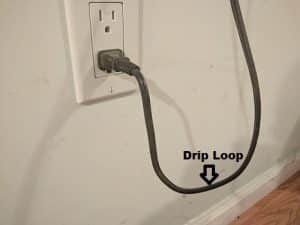In order to maintain the water quality of your aquarium, you will most likely use electronically devices. With that said, water and electricity are a deadly mix for your equipment, fish, you and your loved ones. Thus, it is best to take some precautions when it comes to powering your aquarium equipment.
Protecting your power outlet
In a perfect world, your fish tank should be placed above your power outlet. Doing so will prevent water from easily getting into the outlet. Needless to say water is most likely travel downwards then upwards when leaving your tank.
With that said, water splashes may be able to reach your power outlet even if it is located higher than the tank. So, if possible, you may want to place your aquarium a safe distance from a power outlet. You can then use a heavy duty power extension cord with waterproof jacket. If you are interested in doing so, we recommend checking out the Southwire 2588SW0002 Outdoor Extension Cord on Amazon. (#CommissionsEarned)
Surge protection
Power surges, which can occur during lightning storms and power outages, can damage your aquarium equipment (especially heaters). This is especially true if you are living in an older house/apartment. To prevent power surges, you should get a surge protector.
The amount of protection a surge protector offers is calculated in a unit called joules. Every time a power surge is prevented, the amount of joules will be depleted. While you have to replace the protector eventually as it wears down, there is usually no way to tell when you have to do so.
Surge protector warranty
Since you most likely won’t know when your surge protector will stop working, then you should purchase a product that offers a connected equipment warranty. Doing so will ensure that you equipment will get replaced or repaired if they get damaged during a power surge as you as you were properly connecting the affected devices.
We recommend getting the Belkin 12-Outlet Pivot-Plug Power Strip Surge Protector as it comes with ample Joules at 4,320. Not to mention that it is also backed by a lifetime warranty in addition to a $300,000 connected equipment warranty. You can purchase the Belkin 12-Outlet Pivot-Plug Power Strip Surge Protector with this link on Amazon. (#CommissionsEarned)
Uninterruptible Power Supply System
In addition to power surges, you should also worry about power loss. During a blackout, your chiller/heater, filter and other fish tank equipment won’t work. As a result, you fish could suffer due to the changing temperature and lack of oxygen. Not to mention that the beneficial bacteria will begin to die off.
Due to the aforementioned reasons, you should look for a Uninterruptible Power Supply System. This device is designed to provide battery backup if you have no access to electrical for an extended period of time.
We suggest getting the CyberPower CP1500AVRLCD Intelligent LCD UPS System as it comes with a $500,000 connected equipment guarantee in addition to having a LCD display. You can buy the CyberPower CP1500AVRLCD Intelligent LCD UPS System on Amazon. (#CommissionsEarned)
Where to place your surge protector and/or UPS system
As we mentioned above, you should place your surge protector and/or uninterruptable power supply system somewhere above your aquarium to prevent water from splashing on to the outlets. Some surge protectors, have holes where you can put a screw in to hang on a wall. If your device don’t have one, you can use some kind of adhesive. You can also simply lie it down on some elevated platform.
Although the condensation can damage both devices, putting a top on your fish tank will heavily limit the amount of evaporation, and thus, condensation.
If you want to be extra careful, then we recommend picking up a small dehumidifier to remove moisture from the air. If you are interested in doing so, then we suggest taking a look at the Pro Breeze Electric Mini Dehumidifier via this link on Amazon. (#CommissionsEarned)
Drip loop method
Whether you are connecting your aquarium equipment to a power outlet, surge protector or uninterruptible power supply, we highly suggest using the drip loop method. To do a drip loop, we recommend using a rubber band to tie a portion of the wire closest to the connector to create a downward loop. You can find an example of a drop loop via the image we posted below this paragraph.

If done correctly, the loop will prevent water running on the wire from entering the power outlet due to gravity.
Recap
You should be extra careful when powering your aquarium equipment since you are dealing with water and electricity.
We at Aquarium Blueprints recommend placing your tank above and away from a power outlet via an extension cord. There are also several water-protection you can get for your power cables.
To protect against power surges and power failures, you should surge protection as well as an Uninterruptible Power Supply System.
